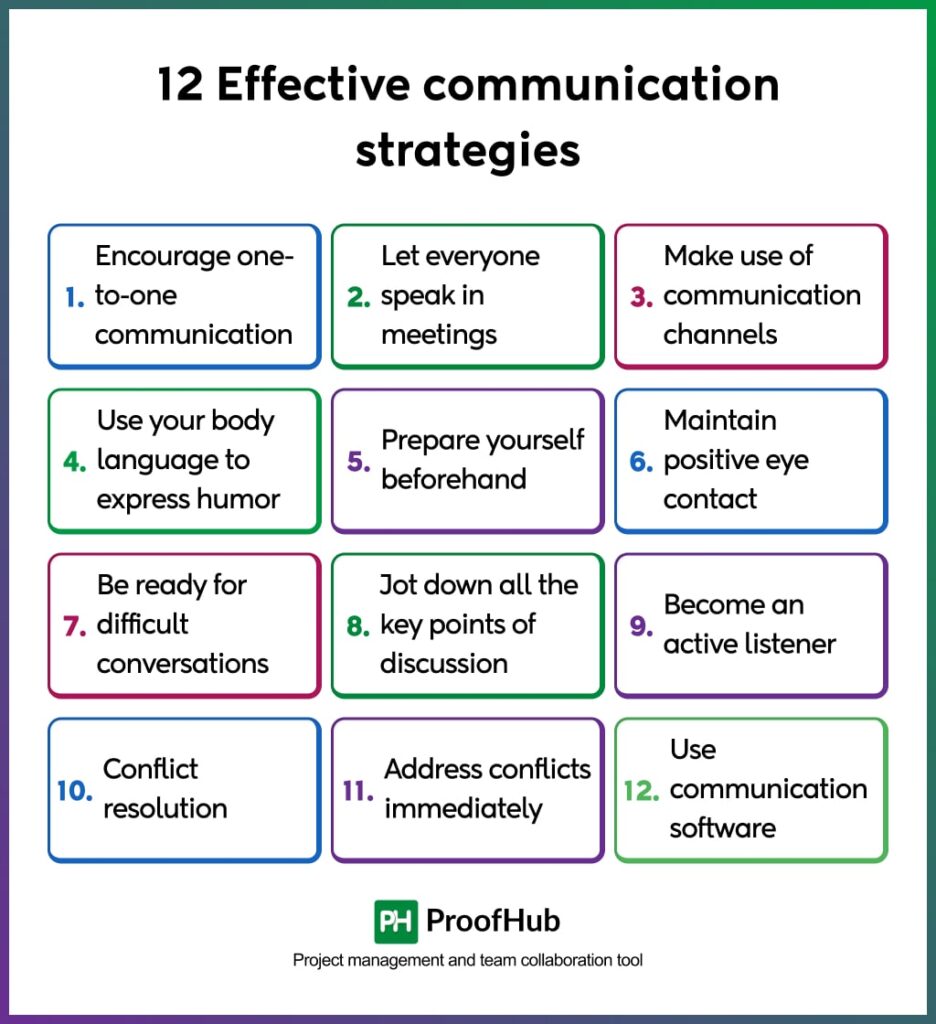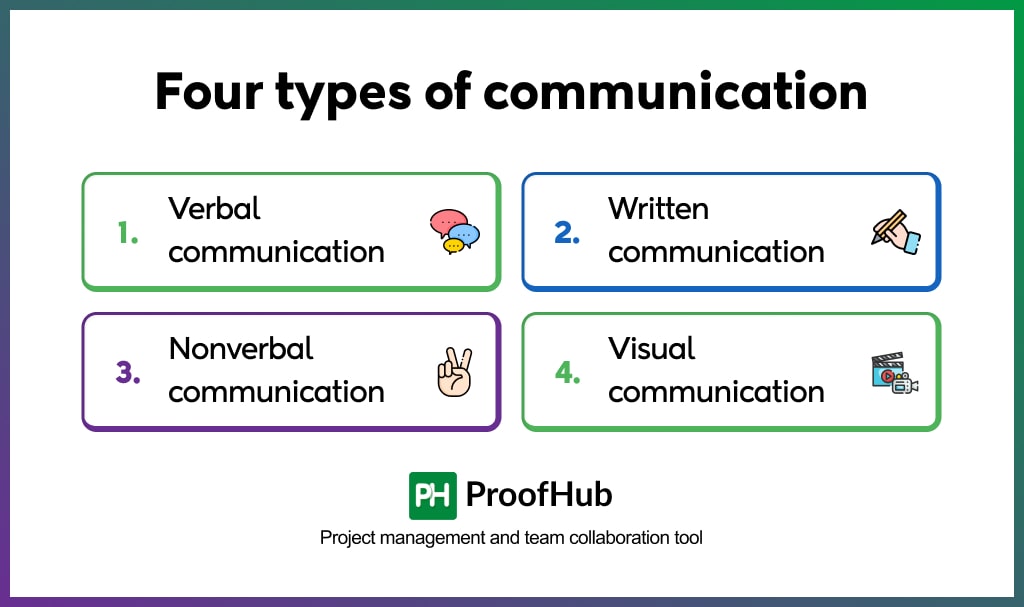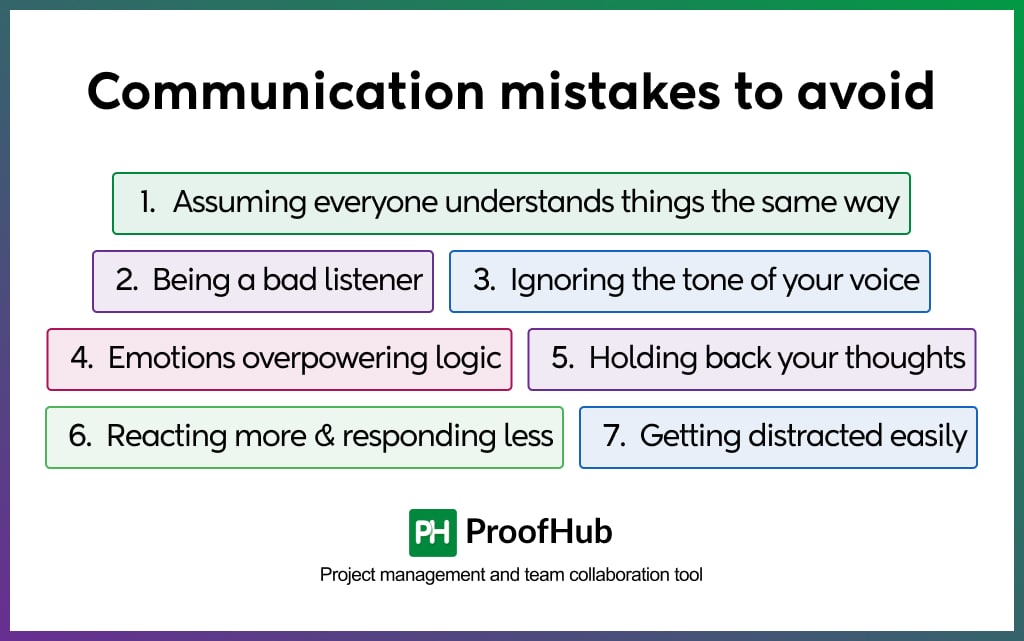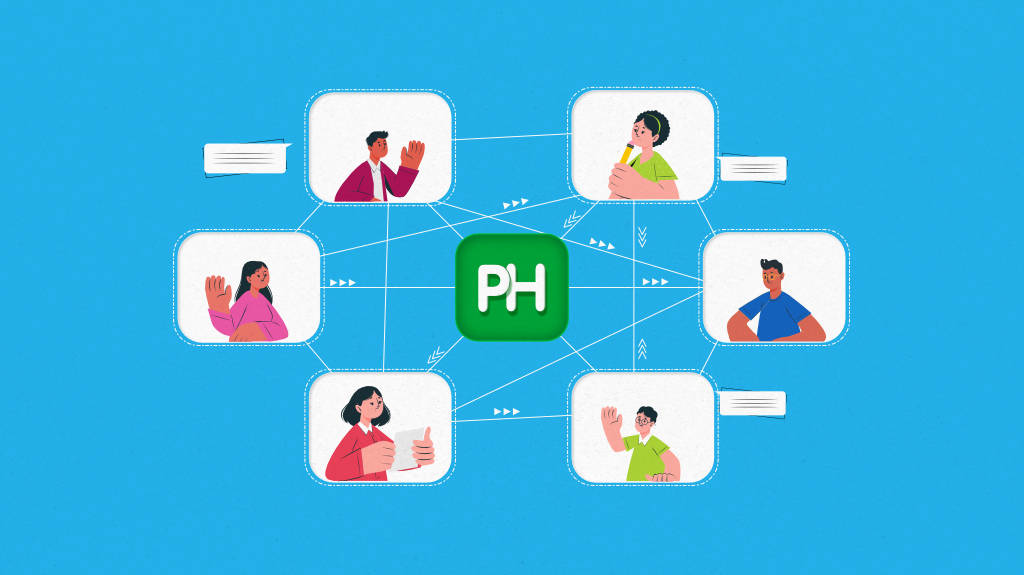Effective communication is the backbone of any successful workplace. Whether you’re managing a team, working on a project, or interacting with clients, the ability to convey information accurately can have direct implications.
Clear and consistent communication helps prevent misunderstandings and promote a healthy, collaborative environment. Communicating effectively makes team members more likely to feel engaged and aligned with the organization’s goals.
In this article, we’ll explore what communication strategies are, their importance, different types of communication, strategies for communicating effectively, and common mistakes you should avoid.
What are communication strategies?
Communication strategies are planned ways used to deliver messages clearly and effectively within an organization or team. A well-crafted communication strategy aligns with organizational goals, improves collaboration, and helps prevent misunderstandings.
Importance of communication strategies
A communication strategy provides a clear framework for sharing information within an organization or team. It plays a crucial role in making communication effective by ensuring that messages are delivered efficiently
Here are a few ways a well-defined communication strategy can help:
- Clarity and consistency: It ensures everyone receives the same information, reducing confusion and keeping everyone aligned on goals and tasks.
- Improved efficiency: Clear guidelines for communication channels and methods prevent delays and ensure that the correct information reaches the right people at the right time.
- Stronger relationships: A strategy encourages open, transparent communication, fostering trust among employees, managers, and clients.
- Conflict reduction: When communication is structured and transparent, there’s less chance of misinterpretation or conflict, promoting a more positive and collaborative work environment.
12 Effective communication strategies in the workplace
Peers and colleagues need to interact and communicate effectively with one another occasionally. Good communication strengthens the bond among the members and facilitates the overall process of information-sharing. Additionally, as communication is a vital part of our life outside work, it’s better to level up your communication skills, boost motivation, and make it one of your key strengths.
Here’s a popular quote by John Powell that will motivate you to put effort into improving your communication skills:
“Communication works for those who work at it.”
Now, let us take a look at the strategies for effective communication that you and your teammates should follow to make interaction both fun and rewarding:

1. Encourage one-to-one communication
One-to-one communication is a crucial communication strategy that helps to develop a bond and understand your teammates in a better way. When you talk to others personally, you learn more about them. You can read their body language and learn about the communication methods that they are most comfortable with.
Additionally, when you need to share confidential information with someone, you must communicate one-on-one. You can easily talk about matters privately and get suggestions from a single person without involving others in your workforce.
Encouraging such personalized interactions is a simple yet effective way to improve workplace communication, foster trust, and strengthen team relationships.
2. Let everyone speak in meetings
Yes, I agree that meetings may get boring and seem more like a formality. But this usually happens when a limited number of participants have the privilege of sharing what’s on their minds. With defined agendas, the involvement of only those directly related to the issues discussed ensures productive time utilization.
It doesn’t matter whether you are a team leader or a member; you need to express your thoughts openly during a meeting. The manager or the meeting organizer is responsible for ensuring that every participant gets an equal chance to express what’s on their mind. Effective leadership ensures these opportunities are provided and utilized to their fullest potential.
Moreover, participants must listen carefully to what others say without interrupting them. This will make the meeting more open and allow everyone to hone their speaking and listening skills.
3. Make use of communication channels
Some people prefer talking face-to-face, while others find it more effective to send text messages to convey messages. You may want to stick with your favorite communication channels, but this doesn’t make communication within a team easy for you in the long run.
Like you, everyone has their own set of preferred modes of communication. However, to convey your messages to everyone in your group without friction, you need to make yourself comfortable with different modes of communication. You can get closer to becoming a communication expert by using various channels to communicate with your team.
4. Use your body language to express humor
Body language enhances the message that you are about to deliver. Hand signals, gestures, and postures help you in expressing your emotions in a professional environment. Too serious conversations can put you and other participants in a negative mind. This will affect how you perceive the message and draw conclusions.
Moreover, when a communication session becomes too severe, everyone wants to leave it as soon as possible, and the flow of information gets hindered significantly.
Sometimes, you must convey an intense message, and avoiding a stressful communication session is impossible.
In such a case, you should know how to lighten your mood and that of others. Include a good joke along with positive body language to do the trick. This helps everyone relax and retain their interest in the discussed matter.
5. Prepare yourself beforehand
Don’t take things too lightly; always prepare to share important information with your peers beforehand. You don’t want to skip any piece of detail while communicating the message with your team.
It’s always a good idea to note down all the essential points you want to communicate with your team. Also, it would be best if you focused on presenting information interestingly and engagingly. It’s a good practice to customize what you want to share as per their nature.
6. Maintain positive eye contact
An important aspect during a feedback session is eye contact. This can help you portray interest, attention, emotion, and intention. Also, continuous on-off eye contact ensures the participants are interested in the proceedings. Eye contact during feedback sessions also ensures you do not accidentally convey a wrong message.
Communication is a two-way process, and information cannot be exchanged effectively if the flow is unidirectional. Feedback improves the overall effectiveness of communication by enabling the flow of information in the backward direction. The most common example of feedback is the questions you ask at the end of a presentation.
Feedback can be in the form of doubts, suggestions, or thoughts you will get after you communicate your message. One more thing about positive feedback is that it improves the performance of the individuals.
7. Be ready for difficult conversations
Sometimes, you may find yourself conversing with someone whose thoughts, opinions, and feelings are entirely different from yours. The two most obvious choices in such a circumstance are avoiding the conversation or getting involved in an argument.
However, neither of these methods will do the trick: to make communication happen effectively while keeping personal differences aside. So, what you need to do to tackle a difficult conversation is to stay relaxed and try to understand what the other person wants to say before responding.
Also, you can practice how you respond when you get into tricky conversations that can happen with your manager or your colleagues.
8. Jot down all the key points of discussion
While communicating with your team, especially during a discussion or a meeting, you witness the flow of significant information and ideas. However, it’s difficult to retain all the valuable facts that are shared verbally with one another. As a result, it is likely to lose most parts of the conversation that may come in handy.
To ensure that discussion brings productive results and information does not get lost, you need to note down every piece that seems valuable. This way, you can secure many ideas that otherwise would have been lost.
9. Become an active listener
Becoming an active listener is vital for fostering clear and open communication. It ensures that employees hear and fully understand what is being said by engaging with the speaker, asking questions, and providing feedback. The quality of active listening leads to fewer misunderstandings and improved collaboration and creates an environment where everyone feels valued and heard. Active listening is a cornerstone of effective communication because it builds trust and encourages transparency.
10. Conflict resolution
Conflict resolution is equally essential because workplace disagreements if left unaddressed, can disrupt communication, create tension, and lower team morale. A well-implemented conflict resolution strategy ensures that issues are handled constructively and professionally, allowing all parties involved to express their views and find a mutually beneficial solution. This resolves the immediate conflict and promotes healthier communication habits moving forward.
11. Address conflicts immediately
Addressing conflicts immediately is critical for maintaining a smooth and productive communication flow. Delaying conflict resolution can escalate unresolved issues, hamper open communication, and negatively impact the workplace culture. By resolving conflicts as soon as they arise, teams can maintain trust, focus on their tasks, and prevent communication breakdowns.
12. Use communication software
Today, numerous software have emerged that make it easy to communicate and share your thoughts and ideas conveniently. You can use online team collaboration tools for instant messaging, video conferencing, brainstorming, note-taking, etc.
You can also use project management software like ProofHub, which has an integrated chat tool and various other collaboration features. You can stay connected with your team and manage all your projects using a single application.
Incorporating advanced communication or collaboration technology will make it easy and effective to communicate with your team.
For better communication and collaboration, you need a smart team collaboration tool.
What are the types of communication?
Generally, there are several types of communication that individuals can use to exchange information with one another. However, the four most common methods of communication used in organizations are as follows:

1. Verbal communication
Verbal communication is the most common method of communication used by teams within organizations. It is a communication method in which the information is exchanged verbally. The individual behaving as the source transmits the data by speaking or making sound patterns. In contrast, the person at the receiving end must listen to the words or sounds to get the information.
Several factors decide the effectiveness of your communication, such as clarity of speech, tone, word selection, speech rate, etc. Additionally, active listening skills also matter a lot in deciding the overall success of communication.
2. Written communication
Written communication is another communication method teams use to disseminate data in the form of words or symbols written, usually on paper or similar materials.
The individual who wants to communicate the message must write it on paper, and the individual at the receiving end must read the message to understand it. The best thing about written communication is that it records the messages one can access and go through multiple times.
Words are of paramount importance when opting for written information. Unlike verbal communication, the person at the receiving end cannot perceive the emotions of the individual drafting the message.
Thus, the tone of writing and selection of words is crucial to ensure the reader gets the correct information.
3. Nonverbal communication
In nonverbal communication, information is transmitted using gestures, postures, and facial expressions. An individual can convey information using visual cues like body language, eye contact, etc.
One important thing to notice about nonverbal communication is that it can also happen unintentionally, as non-verbal communication has many types. For example, not looking at the person sharing an idea with you most likely means that you are either not interested or disagree with the idea.
4. Visual communication
Visual communication uses signs, drawings, illustrations, graphics, pictures, etc., to communicate information and messages. Choosing the correct elements can make it easier for individuals to interpret the data.
Both verbal and written communication can use visual elements to make the information more understandable. The most common instance where visual communication is used alongside verbal and written communication is during team meetings
Communication mistakes to avoid
Before you start implementing the strategies for effective communication we’ve discussed, ensure you are not making any common communication mistakes.
Here are some of the most common communication blunders that can lead to ineffective conversations:

1. Assuming everyone understands things the same way
When you communicate with several people at a time, some are expected to get it quickly, while others cannot understand your point. This happens because of differences in understanding levels and preferred learning styles.
Moreover, you can never assume that all people interpret your message similarly. Thus, it would help if you encouraged your team members to ask questions immediately. The one-size-fits-all approach never works when it comes to communication.
2. Being a bad listener
Communication is not only about speaking but also about listening and receiving information. In any conversation, one person shares the information by speaking while the other person listens and interprets.
So, you must understand here that listening skills matter as much as speaking skills. When you listen actively to others, you can understand things quickly, and learning becomes easier.
Individuals who are bad at listening are less likely to extract the correct details from the conversations. This builds up barriers that hinder the smooth functioning of the workflow.
3. Ignoring the tone of your voice
When you communicate verbally, your voice’s tone matters a lot. Voice creates a major impact and is a key factor in determining how well your team members connect with you. Communicating in a harsh and annoying tone is likely to hurt them.
In worst-case scenarios, such instances result in conflicts. It would be best to make sure that your voice is gentle, confident, educating, and should imply that you are also willing to listen.
4. Emotions overpowering logic
Conversations influenced by your emotions are ineffective and are likely to bring in undesired outcomes, especially in the office environment. You need to think and communicate logically while keeping your feelings aside.
Most decisions that are guided by emotions are likely to be the ones that you regret later. It’s pretty tricky, but you must resist your emotions from taking over your logical thinking.
5. Holding back your thoughts and ideas
Not expressing your thoughts while communicating can bring conversations to a dead end. It’s essential to share what’s on your mind with others to get your issues and requests noticed.
It would be best to communicate your opinions confidently to ensure that others don’t take them too lightly.
6. Reacting more and responding less
Reacting and responding are two different things. When you react, you take action without properly considering the consequences and the impact they will make. Generally, reactions are aggressive and tense.
On the other hand, responding means taking time to think about the issue or the situation and then taking action accordingly. Reactions are not good, especially when you are communicating with people on a professional level.
A single reaction during a conversation can induce multiple reactions that will create a hateful environment and kill productivity.
7. Getting distracted easily
While exchanging information with others, you must always pay attention to ensure you don’t miss anything important. Distractions can put you in a situation where you are physically present in a conversation, but mentally, you become absent.
There can be many reasons for getting distracted while communicating, such as bad attitude, the use of mobile phones, etc. To make any conversation successful, you must keep distractions at bay and engage yourself positively.
Wrapping it up
Good communication skills are imperative for becoming successful in the workplace. Whether you are communicating with your team or your boss, you should practice effective organizational communication strategies to take your conversations to the next level at the workplace.
Utilizing tools like ProofHub can greatly enhance your ability to manage and streamline communication, ensuring that everyone is on the same page. I also suggest that you should try to avoid common mistakes that affect any type of communication within your office.
Before you go, I want to share a quote with you that emphasizes the importance of communication:
“Communication – the human connection – is the key to personal and career success.” – Paul J. Meye
Related articles
- What is effective communication? [with benefits and tips]
- Why good communication skills are important for your career (with tips to develop them)
- Essential tips for effective team communication
- Types of internal communication: How to ace each one like a pro
- Internal communication challenges and how to fix them
- Ways to improve internal communication in the workplace
- Amazing team communication tools for businesses

